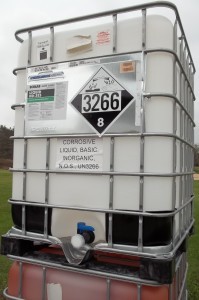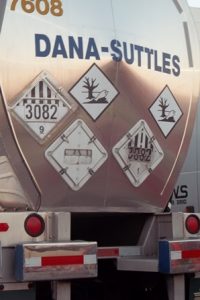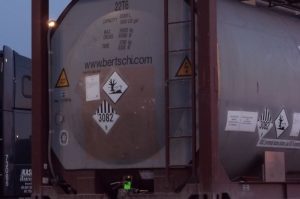The purpose of this article is not to identify and explain a marine pollutant as regulated by the Hazardous Material Regulations of the PHMSA/USDOT; you can read all about that here: What is a Marine Pollutant? But, a brief summary will help; a marine pollutant is…
- Defined at 49 CFR 171.8.
- Listed by name in appendix B to the Hazardous Materials Table at §172.101.
- If in a mixture or solution of one or more substances is at or above the following threshold concentrations:
- 10% by weight for a regular marine pollutant
- 1% by weight for a severe marine pollutant (identified with “PP”).
And…
- Not excepted from regulation as a marine pollutant at §171.4(c).
The purpose of this article is also not to identify and explain all of the situations where the marine pollutant marking is not required on a packaging containing a regulated marine pollutant. Those can be found at §172.322(d) and will have to wait to a later article.
Note: To be quite frank, I find the exceptions from the marine pollutant mark detailed at §172.322(d)(1) and (2) to be contradictory and confusing.
The purpose of this article is to identify and explain just one of the four situations – found at §172.322(d)(3) – where the marine pollutant mark is not required on a bulk packaging, freight container or transport vehicle that already bears a HazMat label or placard.
The critical language of §172.322(d):
(d) The MARINE POLLUTANT mark is not required –
…
(3) Except for transportation by vessel, on a bulk packaging, freight container or transport vehicle that bears a label or placard specified in subparts E or F of this part.
It doesn’t look like much, but I’ll break it down line-by-line to make certain I don’t miss anything.
“The MARINE POLLUTANT mark is not required…”
This means that the marine pollutant mark – and only the marine pollutant mark – is affected by this rule. Other markings, labels, or placards required by applicable regulations are not affected by this exception and must continue to be displayed on a packaging or vehicle even if the marine pollutant mark does not.
Also, §171.4 includes several situations where certain marine pollutant packagings are excepted entirely from regulation. This is not that exception.
“Except for transportation by vessel,”
This exception from the requirement to display the marine pollutant marking does not apply to the transport of a marine pollutant by vessel. It does, then, apply to the following modes:
- Highway
- Rail
- Aircraft
“on a bulk packaging, freight container or transport vehicle…”
This exception applies only to the following types of packagings and vehicles:
- Bulk packaging
- Freight container
- Transport vehicle
Each of these types of packagings is defined at §171.8, and below.
Bulk packaging means a packaging, other than a vessel or a barge, including a transport vehicle or freight container, in which hazardous materials are loaded with no intermediate form of containment. A Large Packaging in which hazardous materials are loaded with an intermediate form of containment, such as one or more articles or inner packagings, is also a bulk packaging. Additionally, a bulk packaging has:
(1) A maximum capacity greater than 450 L (119 gallons) as a receptacle for a liquid;
(2) A maximum net mass greater than 400 kg (882 pounds) and a maximum capacity greater than 450 L (119 gallons) as a receptacle for a solid; or
(3) A water capacity greater than 454 kg (1000 pounds) as a receptacle for a gas as defined in §173.115 of this subchapter.
Freight container means a reusable container having a volume of 64 cubic feet or more, designed and constructed to permit being lifted with its contents intact and intended primarily for containment of packages (in unit form) during transportation.
Transport vehicle means a cargo-carrying vehicle such as an automobile, van, tractor, truck, semitrailer, tank car or rail car used for the transportation of cargo by any mode. Each cargo-carrying body (trailer, rail car, etc.) is a separate transport vehicle.
I won’t go into extensive detail about the three packaging types identified (except for bulk packagings, I have a whole article written just about them and you can read it here: Bulk Packaging for HazMat Explained!)
That may not seem like much, but those three terms are broad enough to include the most common packagings used to ship HazMat and most non-vessel vehicles. What they does not include are non-bulk packagings, i.e. those with a capacity of equal to or less than 119 gallons.
“…that bears a label or placard specified in subparts E or F of this part.”
This sentence is the key to the whole exception. It is also quite simple: If meeting all of the above criteria, a packaging of a marine pollutant, or a transport vehicle containing one, is not required to display the marine pollutant mark if it also displays a HazMat label or placard as required by the Hazardous Material Regulations. In other words, the display of any HazMat label or placard on an applicable packaging or vehicle – if that label or placard is specified by the regulations – precludes the requirement to display the marine pollutant mark.
So, the display of the marine pollutant mark on this cargo tank (an example of a bulk packaging) is not required.
Question: But what about a situation where the Class 9 Miscellaneous placard is displayed? Does this exception apply then? After all, the Class 9 Miscellaneous placard may be displayed but is not required when transport takes place within the U.S. Answer: This exception applies even when the Class 9 Miscellaneous placard is displayed at the discretion of the carrier and is not required by regulation (LOI 95-0126). Also read: Is the Class 9 Placard Required?
So, the display of the marine pollutant mark is not required on this cargo tank either.
Question: But is it OK to display the marine pollutant mark even when it is not required? Answer: Sure, go ahead. You won't be alone.
Still have questions? I don’t blame you. Be sure to research this regulation for yourself and contact me with any questions. Also be sure to contact me if you require HazMat Employee training for you or your employees.






